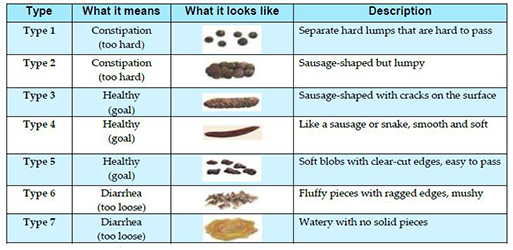Patient EducationOct | 21 | 2019
Tips for Healthy Bowel Movements
Learn about healthy bowel movements, how to help if there is trouble with bowel movements and guidelines on how to prevent constipation and maintain a healthy digestive system. If needed, ask the care team for a chart to help track bowel movements.
What is a healthy bowel movement?
Healthy bowel movements can be described as 1-2 stools a day that are easily passed. The stools have the texture of peanut butter or mashed potato.
Here are some suggestions to help with regular healthy bowel movements
- Eat lots of fruits, vegetables and whole grains. In addition, drink plenty of fluids. When combined with plenty of fluids, the fiber in fruits, vegetables and whole grains can make it easier to have more regular bowel movements.
- Limit milk and dairy because they can be constipating. It is also best to stay away from processed foods.
- Encourage taking part in enjoyed physical activity for at least 30 minutes per day.
- Create a regular sitting plan with the care team (planned time to sit on the toilet to help bowel movements come on a regular schedule and prevent constipation).
Here is a chart of different bowel movements. This is a stool chart.

Where there is trouble with bowel movements, the care team suggests:
In addition to following general healthy guidelines, the care team recommends staying on a “maintenance” bowel plan to keep regular and healthy bowel movements. Follow the plan every day to prevent constipation from causing a backup of stool.
Here is the daily plan prescribed for: _______________________________________
Stool softener
We usually suggest Miralax® (polyethylene glycol)
How it works:
Moves water from the body to the intestines to soften stool. Miralax® is safe to use in both children and adults.
How to give Miralax®:
- Check the Bristol Stool Chart to see which type of bowel movement the care team is treating.
- Mix __________ capfuls / teaspoons with a favorite drink. Give __________ times per day. *When using Miralax®, 1 capful = 4 teaspoons
- After a few days, adjust the dose of Miralax® up or down, depending on the type of bowel movement.
- For bowel movements Type 1 and 2, increase Miralax® by __________ more until bowel movements reach Type 3, 4 or 5.
- For bowel movements Type 6 and 7, decrease Miralax® by __________ less, until bowel movements reach Type 3, 4 or 5.
If more than 24-48 hours (1-2 days) has passed without a bowel movement, add: _________________________.
Stimulant laxatives
We suggest a variety of over-the-counter medications. Find one that works well for the individual’s needs.
How these work:
Helps the muscles in the colon (large intestine) contract to move stool out of the body.
How to give stimulant laxative
How you give stimulant laxatives depends on which kind you give. Depending on the need, give daily or as directed by the care team.
Choose just ONE of the following:
- Senna or Ex-Lax®: __________ tablets/squares
- Dulcolax® or bisacodyl: __________ tablets
- Magnesium Natural Calm®: Mix __________ teaspoons into a favorite drink.
- Magnesium oxide tablets: __________ tablets
- Pedia-Lax®: __________ watermelon chews
If more than 24-48 hours (1-2 days) has passed without a bowel movement, add ___________________________.
Rev. 8/2018. Mass General for Children and Massachusetts General Hospital do not endorse any of the brands listed on this handout. This handout is intended to provide health information so that you can be better informed. It is not a substitute for medical advice and should not be used to treatment of any medical conditions.
Related Pages
Type
Patient Resources
Patient Resources for the Lurie Center for Autism
Appointments and Referrals
Request an appointment or second opinion, refer a patient, find a doctor or view test results with MGfC's secure online services.

